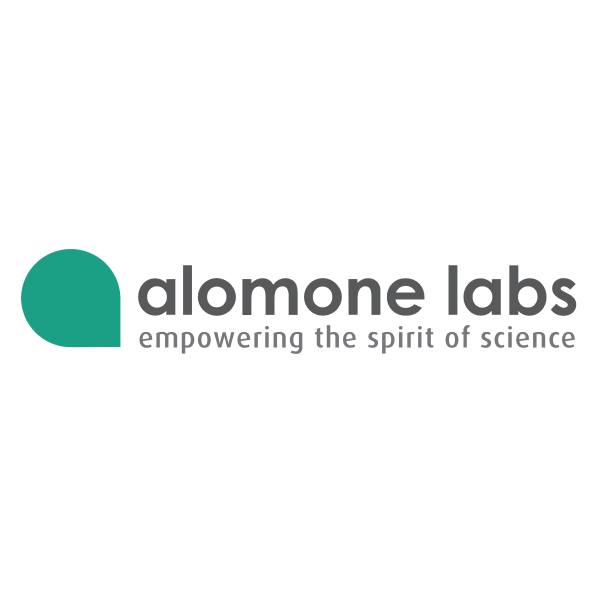

品牌: Alomone
 下载产品说明书
下载产品说明书 用小程序,查商品更便捷
用小程序,查商品更便捷



 收藏
收藏
 对比
对比 咨询
咨询纯度:
Affinity purified on immobilized antigen.
Affinity purified on immobilized antigen.
反应种属:
M, R
M, R
产品介绍
产品信息
纯化方式
Affinity purified on immobilized antigen.

宿主
Rabbit

免疫原
Peptide (C)ESLKRWNEERGLW(S)EK, corresponding to amino acid residues 2-17 of rat CACNG8 (Accession Q8VHW5). Intracellular, N-terminus.

简单描述
A Rabbit Polyclonal Antibody to CACNG8 (CaVγ8) Subunit

商品描述
Alomone Labs is pleased to offer a highly specific antibody directed against an epitope of rat TARP gamma-8 (CaVγ8, CACNG8). Anti-CACNG8 Antibody (#ACC-125) can be used in western blot and immunohistochemistry applications. It has been designed to recognize TARP gamma-8 from rat, mouse and human samples.

同种型
Rabbit IgG.

纯度
Affinity purified on immobilized antigen.

形式
Lyophilized

组成成分
免疫球蛋白G型抗体

基因
CACNG8

应用
实验应用
IF, IHC, WB

反应种属
M, R

预测反应种属
H

背景
别名
CaVγ8, Voltage-dependent calcium channel gamma-8 subunit, TARP gamma-8, Transmembrane AMPAR regulatory protein gamma-8

背景
Transmembrane AMPA receptor regulatory proteins (TARPs) serve as auxiliary subunits of AMPA receptors that regulate functional aspects of these receptors such as: fast excitatory synaptic transmission, surface trafficking, enhancing synaptic clustering and increasing glutamate affinity. Generally, TARPs are responsible for regulating expression, channel properties and localization of AMPA receptors in the brain1.
TARPs are non-pore-forming integral membrane proteins with four transmembrane domains that are widely expressed in the CNS.
The TARP family is divided in Type I and type II subfamily. Type I TARPs comprise four calcium channel γ subunits: γ2, γ3, γ4, and γ-8, also known as Cacng2, 3, 4 and 8, respectively2,3.
γ-8 TARP predominantly expressed in the telencephalon with abundant distribution on hippocampal excitatory synapses and extrasynaptic membranes. It is expressed in low levels in newborn and neonatal brain and can be found in higher levels in adult brain4. γ-8 plays an important role in increasing the number of synaptic and extrasynaptic AMPA receptors on dendrites and spines5.
The C terminus of γ-8 contains 3 unique stretches of amino acids that are not found in any of the other TARPs. In addition, it contains PDZ-binding motifs2. In heterologous cells, γ-8 prolong the current rise time in response to small amounts of glutamate and slow GluA1 receptor desensitization and deactivation3.
Several studies have shown that overexpression of TARP γ-8 increases the number of AMPARs in the plasma membrane. In γ-8 knockout mice, AMPA receptor expression is severely reduced from the synaptic and extrasynaptic membranes of dendrites and does not progress through the secretory pathway5,6.
TARPs are non-pore-forming integral membrane proteins with four transmembrane domains that are widely expressed in the CNS.
The TARP family is divided in Type I and type II subfamily. Type I TARPs comprise four calcium channel γ subunits: γ2, γ3, γ4, and γ-8, also known as Cacng2, 3, 4 and 8, respectively2,3.
γ-8 TARP predominantly expressed in the telencephalon with abundant distribution on hippocampal excitatory synapses and extrasynaptic membranes. It is expressed in low levels in newborn and neonatal brain and can be found in higher levels in adult brain4. γ-8 plays an important role in increasing the number of synaptic and extrasynaptic AMPA receptors on dendrites and spines5.
The C terminus of γ-8 contains 3 unique stretches of amino acids that are not found in any of the other TARPs. In addition, it contains PDZ-binding motifs2. In heterologous cells, γ-8 prolong the current rise time in response to small amounts of glutamate and slow GluA1 receptor desensitization and deactivation3.
Several studies have shown that overexpression of TARP γ-8 increases the number of AMPARs in the plasma membrane. In γ-8 knockout mice, AMPA receptor expression is severely reduced from the synaptic and extrasynaptic membranes of dendrites and does not progress through the secretory pathway5,6.

制备和贮存
溶解方法
25 µl, 50 µl or 0.2 ml double distilled water (DDW), depending on the sample size.

保存方式
The antibody ships as a lyophilized powder at room temperature. Upon arrival, it should be stored at -20°C.
数据库链接
Entrez-Gene ID
140729

UniProt ID
Q8VHW5

研究资源识别码
AB_2756551.

声明 :本官网所有报价均为常温或者蓝冰运输价格,如有产品需要干冰运输,需另外加收干冰运输费。







 危险品化学品经营许可证(不带存储) 许可证编号:沪(杨)应急管危经许[2022]202944(QY)
危险品化学品经营许可证(不带存储) 许可证编号:沪(杨)应急管危经许[2022]202944(QY)  营业执照(三证合一)
营业执照(三证合一)